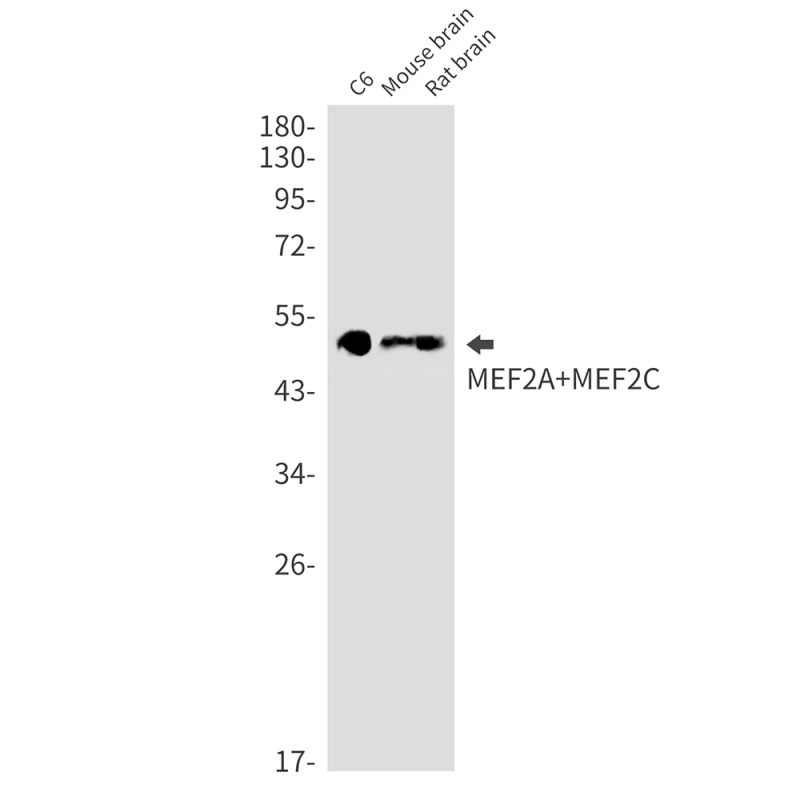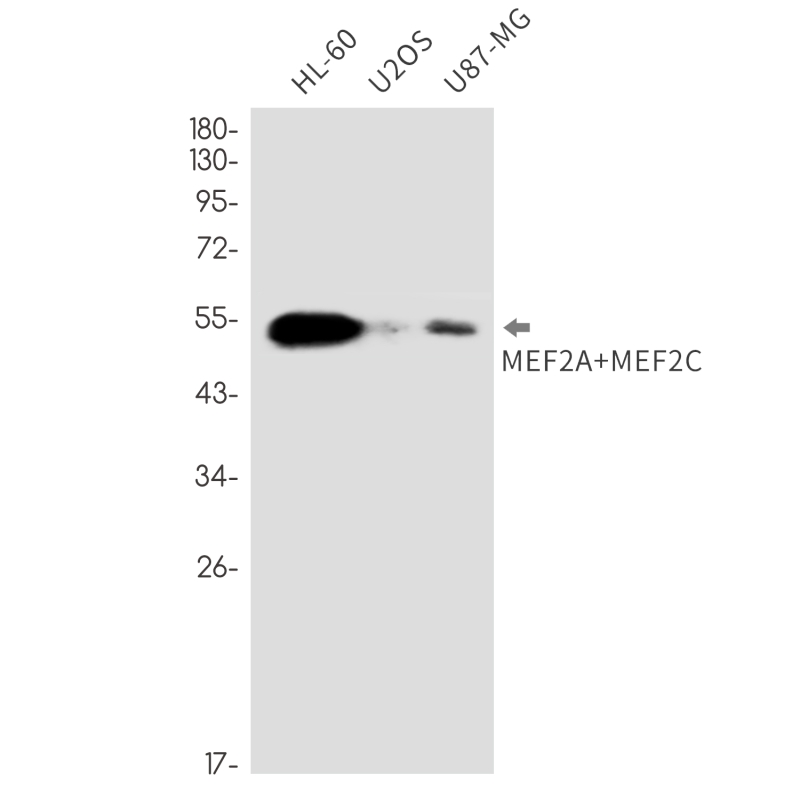

| WB | 1/500-1/1000 | Human,Mouse,Rat |
| IF | 咨询技术 | Human,Mouse,Rat |
| IHC | 咨询技术 | Human,Mouse,Rat |
| ICC | 技术咨询 | Human,Mouse,Rat |
| FCM | 咨询技术 | Human,Mouse,Rat |
| Elisa | 咨询技术 | Human,Mouse,Rat |
| Aliases | ADCAD1; MEF2; MEF2A; Myocyte enhancer factor 2A; RSRFC4; RSRFC9 |
| Entrez GeneID | 4208/4205 |
| WB Predicted band size | Calculated MW: 51 kDa; Observed MW: 51 kDa |
| Host/Isotype | Rabbit IgG |
| Antibody Type | Primary antibody |
| Storage | Store at 4°C short term. Aliquot and store at -20°C long term. Avoid freeze/thaw cycles. |
| Species Reactivity | Human,Mouse,Rat |
| Immunogen | A synthesized peptide derived from human MEF2A+MEF2C |
| Formulation | Purified antibody in TBS with 0.05% sodium azide,0.05%BSA and 50% glycerol. |
+ +
以下是3-4篇关于MEF2A/MEF2C抗体的代表性文献(简略版):
1. **文献名称**:*MEF2C regulates cortical synaptic and cognitive function in rodent models of Alzheimer's disease*
**作者**:Li H, et al.
**摘要**:研究利用MEF2C抗体分析小鼠模型大脑皮层中MEF2C蛋白表达,发现其缺失导致突触功能障碍,提示MEF2C在阿尔茨海默病相关认知衰退中的作用。
2. **文献名称**:*Cardiac-specific deletion of Mef2a alters mitochondrial dynamics and causes cardiomyopathy*
**作者**:Kim Y, et al.
**摘要**:通过MEF2A抗体进行Western blot和免疫组化,证明MEF2A缺失引发心肌线粒体结构异常,揭示其在心脏能量代谢中的调控机制。
3. **文献名称**:*MEF2C suppresses colorectal cancer progression via inhibiting NF-κB signaling*
**作者**:Wang L, et al.
**摘要**:使用MEF2C抗体检测结直肠癌组织样本,发现MEF2C通过抑制NF-κB通路抑制肿瘤转移,提示其作为抑癌因子的潜力。
4. **文献名称**:*Activity-dependent MEF2C nuclear translocation in hippocampal neurons*
**作者**:Cohen TJ, et al.
**摘要**:通过免疫荧光结合MEF2C抗体,发现神经元活动可诱导MEF2C核转位,调控学习记忆相关基因表达。
注:以上内容为简化示例,实际文献需根据具体研究调整。
MEF2A (Myocyte Enhancer Factor 2A) and MEF2C (Myocyte Enhancer Factor 2C) are transcription factors belonging to the MEF2 family, which play critical roles in regulating gene expression during cellular differentiation, development, and stress responses. These proteins contain a conserved MADS-box domain and a MEF2-specific domain, enabling DNA binding and interaction with co-regulators. MEF2A/C are widely expressed in muscle, neuronal, and immune cells, where they regulate genes involved in myogenesis, neurodevelopment, synaptic plasticity, and inflammation. Their activity is tightly modulated by post-translational modifications (e.g., phosphorylation, acetylation) and interactions with partners like histone deacetylases (HDACs) or MAP kinases.
Antibodies targeting MEF2A/C are essential tools for studying their expression, localization, and function. They are commonly used in techniques such as Western blotting (WB), immunohistochemistry (IHC), chromatin immunoprecipitation (ChIP), and immunofluorescence (IF). These antibodies help identify MEF2A/C protein levels in tissues or cultured cells, assess their nuclear-cytoplasmic shuttling, or map DNA-binding sites in gene regulatory regions. Given the involvement of MEF2A/C in diseases like cardiovascular disorders, neurodegenerative conditions, and cancer, such antibodies are pivotal in biomedical research. Validation steps (e.g., knockout controls, peptide blocking) ensure specificity, as MEF2 family members share structural homology. Their applications span developmental biology, neurobiology, and mechanistic studies of transcriptional regulation.
×